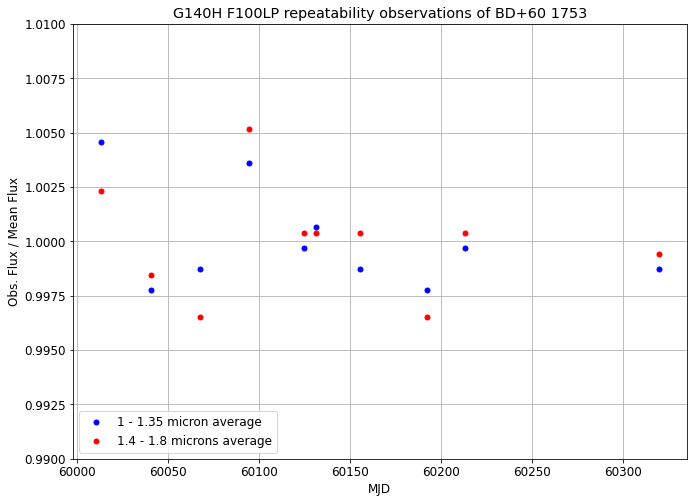NIRSpec Fixed Slit Calibration Status
The overall calibration status and estimated accuracy of NIRSpec fixed slit (FS) observations are described in this article; please also see the article on known issues affecting NIRSpec fixed slit data.
On this page
Photometric calibration
Date:
Current fixed slit absolute flux calibration is generally better than 5% absolute for sources well centered in the aperture, and should be good to ~3% for most disperser-filter combinations (2% relative). An exception is for observations in S1600A1 at longer than 3.5 µm, where, with the current F-flat reference files, the current absolute flux accuracy can be as low by up to 5%–6%. New F-Flats are expected to be delivered in the near future that should provide FS absolute flux calibration good to 1%–2%.
Data for monitoring the S-flats for the FS subarrays have been acquired in past cycles and there are plans to observe them in the upcoming cycles. If necessary, future updates to the S-flats reference files will be made available.
Caveats:
- The lack of a correction in the pipeline for differences between nodding patterns, which subtract some source flux along with the background, limits the accuracy to about 5% for most modes. The current calibration is optimized for the 3-point nodding pattern for the S200A1, S200A2, and S400A1, and is a compromise between the 3-point nod and no nod correction for the S1600A1. Note that the 5-point dither pattern in the S1600A1 is currently not well handled by the pipeline default settings, leading to a 20% flux underestimate for level 2 and 3 products, although this is easily fixed with customized reprocessing.
- PRISM observations in the narrow S200A1, S200A2, and S400A1 slits may show lower absolute accuracy than the above, as the standard star used to calibrate these combinations was close to saturation with the smallest supported subarray.
- The accuracy of flux corrections for off-centered sources is less well established.
- Achieving the above-quoted accuracy may require rerunning the pipeline with altered parameters, including changes to outlier rejection, weights used for resampling, and the source extraction location.
Photometric repeatability
Date:
Typical broadband flux repeatability over a time scale of months is approximately 0.5%. Any time-dependent trend appears to be smaller than 2% per year.
Limiting S/N: For a bright source observed at multiple dither positions, 50:1 is achievable with modest modifications to default pipeline parameters. At least 100:1 should be possible with more specialized data reduction techniques.
Click on the image for a larger view.
Repeatability is monitored by observing the bright A-type star BD+60 1753 at a cadence of 10 times per year, (monthly with a 2 month gap due to visibility), with the G140H/F100LP in the S1600A1 aperture. These observations show broadband repeatability of ~0.25% for both detectors.
Wavelength calibration
Date:
The wavelength accuracy is similar to the MOS mode. However, like the IFU mode, for the G235H and G395H, FS modes may have modest global dispersion errors, with the shortest wavelengths for these 2 grating having offsets corresponding to as much as -20 km/s shift relative to both the long wavelength end of the same grating and to the true velocity.
